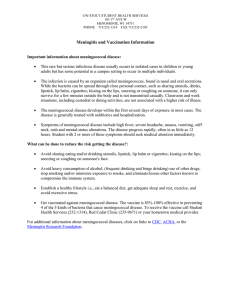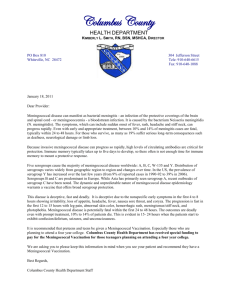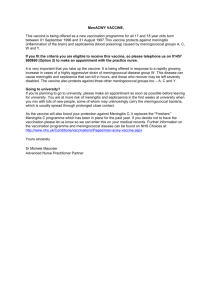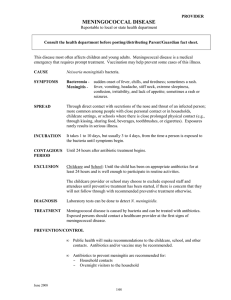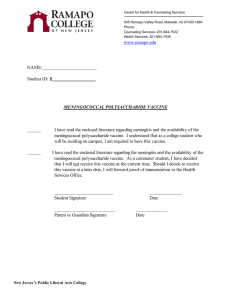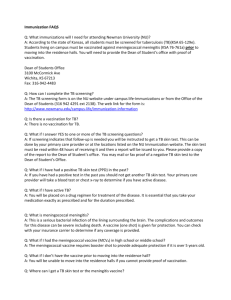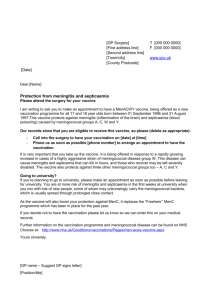meningococcal Know the facts about
advertisement
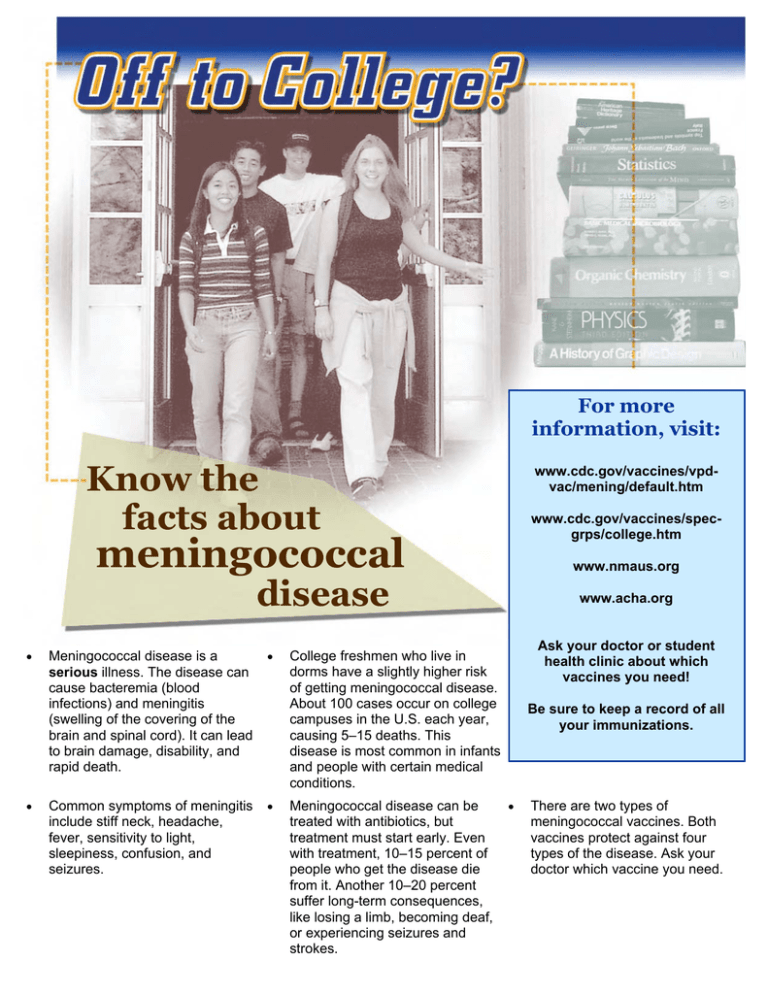
For more information, visit: Know the facts about www.cdc.gov/vaccines/vpdvac/mening/default.htm www.cdc.gov/vaccines/specgrps/college.htm meningococcal www.nmaus.org disease • • Meningococcal disease is a serious illness. The disease can cause bacteremia (blood infections) and meningitis (swelling of the covering of the brain and spinal cord). It can lead to brain damage, disability, and rapid death. • Common symptoms of meningitis include stiff neck, headache, fever, sensitivity to light, sleepiness, confusion, and seizures. • www.acha.org Ask your doctor or student health clinic about which vaccines you need! College freshmen who live in dorms have a slightly higher risk of getting meningococcal disease. About 100 cases occur on college campuses in the U.S. each year, causing 5–15 deaths. This disease is most common in infants and people with certain medical conditions. Meningococcal disease can be treated with antibiotics, but treatment must start early. Even with treatment, 10–15 percent of people who get the disease die from it. Another 10–20 percent suffer long-term consequences, like losing a limb, becoming deaf, or experiencing seizures and strokes. Be sure to keep a record of all your immunizations. • There are two types of meningococcal vaccines. Both vaccines protect against four types of the disease. Ask your doctor which vaccine you need. more information Meningococcal Disease What is Meningococcal Disease? How does Meningococcal Disease Spread? Meningococcal disease is caused by Neisseria meningitidis bacteria. The two most common forms of meningococcal disease are meningitis and bacteremia. Meningitis has other causes as well—the most common being viral infection. Meningococcal disease is spread by coughing, kissing, or sharing anything by mouth with an infected person, such as utensils or toothbrushes. The disease is not spread by casual contact or by breathing the air near an infected person—it requires close contact. Is Meningococcal How can I Avoid Disease Common? Getting No. Meningococcal disease is rare. Meningococcal There are about 2,000–3,000 Disease? cases in the U.S. each year. About 40–80 of these cases occur in Washington State. Getting the meningococcal vaccine is the best protection against the disease. You can also protect yourself by practicing good health habits: • Wash your hands frequently. • Avoid sharing items such as eating utensils, bottles, or lip balm. Some are—college freshmen living in dorms have a slightly higher risk Contact your doctor right away if you are in close contact with of getting meningococcal disease someone who is known or (5.1 cases/100,000 people per suspected to have meningococcal year). Reasons for this increase disease. are not fully understood, but are probably related to crowded living conditions. Are College Students at Higher Risk? Is Meningococcal Vaccine Recommended for College Students? Yes. The meningococcal vaccine is recommended for all persons at higher risk of getting meningococcal disease, including: • Children and adolescents aged 11–18 years. • College freshmen who live in dorms. • People with weakened immune systems. • Travelers to countries where meningococcal disease is common. There are two meningococcal vaccines available (MCV4 and MPSV4). The meningococcal conjugate vaccine (MCV4) is preferred for people aged 2–55 years. Both vaccines protect against four of the five types of meningococcal bacteria. Adapted from the state of California, Health and Human Services DOH 348-086 1RYHPEHU Dear Colleague, The Washington State Department of Health (DOH) provides print-ready files (PDFs) of health education materials. To ensure that the original quality of the piece is maintained, please read and follow the instructions below and the specifications included for professional printing. • Use the latest version. DOH materials are developed using the most current information available, are checked for clinical accuracy, and are field tested with the intended audience to ensure they are clear and readable. DOH programs make periodic revisions to educational materials, so please check this web site to be sure you have the latest version. DOH assumes no responsibility for the use of this material or for any errors or omissions. • Do not alter. We are providing this artwork with the understanding that it will be printed without alterations and copies will be free to the public. Do not edit the text or use illustrations or photographs for other purposes without first contacting us. Please do not alter or remove the DOH logo, publication number or revision date. If you want to use a part of this publication for other purposes, contact the Office of Health Promotion first. • For quality reproduction: Low resolution PDF files are intended for black and white or color desktop printers. They work best if you are making only one or two copies. High resolution PDF files are intended for reproducing large quantities and are set up for use by professional offset print shops. The high resolution files also include detailed printing specifications. Please match them as closely as possible and insist on the best possible quality for all reproductions. If you have questions, contact: Office of Health Promotion P.O. Box 47833 Olympia, WA 98504-7833 (360) 236-3736 Sincerely, Health Education Resource Exchange Web Team
